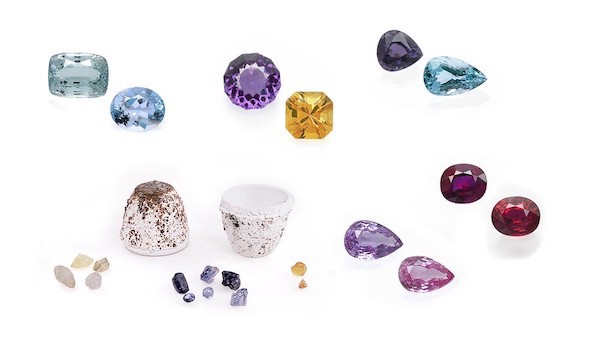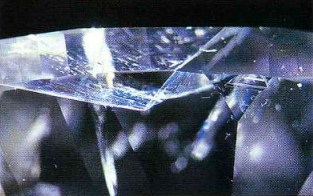
Low-temperature heating of corundum: possibilities and challenges for detection
By Dr. M.S. Krzemnicki, first published in Facette 29 (May 2024)
Heat treatment is generally applied to gemstones to change and enhance their colour. Over the past few decades, it has become a very common practice for certain gem species, such as aquamarine, amethyst (resulting in citrine), copper-bearing tourmalines (Paraiba), tanzanite, and notably for any colour variety of corundum. (Figure 1). But it is important to know that heat treatment of gems has been known since historic times and was described and practiced many centuries ago (see Hughes et al. 2017, and Notari et al. 2019, and references therein). A historic account describing the effect of heating rubies is found in the Book on Mineralogy (trans. Said, 1989) by Al-Biruni (AD 973–1048):
The practice is therefore, to roast the reddish [stones] so that the mixed colours are made to disappear…A ruby stone having been roasted is re- examined, and, in case it does not gain clarity, it is re-heated. ….
This early account explains perfectly the effect of heating on rubies with a purple/blue zone (see Figure 3), and also how even today, a heat treatment can be repeated if the first attempt was unsuccessful.
The effect of heat treatment on a gemstone depends on several different factors. These include external parameters, such as the duration of treatment, gradient of heating and/or cooling, atmosphere (e.g. oxidizing or reducing), and most importantly the peak temperature reached during such a treatment. Intrinsic properties of the gemstone such as the presence and distribution of colouring elements and their valency- state and aggregation and the presence of lattice defects acting as colour centres define how the gemstone responds to a heating process.



Heat treatment detection of corundum
For corundum -Al2O3 (ruby and sapphire and other colour varieties)- various heat treatment processes with or without additives have been developed, specifically in the last few decades (Figure 4). They are widely applied in the gem trade (e.g. in cutting/manufacturing and trading hubs in Sri Lanka, Thailand, India) to enhance the colour and additionally improve -in some cases- the transparency and stability of certain types of corundum. With such heat treatments, it is possible to modify rubies (and other varieties of corundum) of lower quality into visually more beautiful stones, and consequently guarantee a steady supply of gems to the international market.

Heat treatment of ruby and other corundum varieties is usually carried out at temperatures ranging from 700 to 1800 °C. Historically, this has been done using a simple and artisanal blow-pipe (e.g. in Sri Lanka) reaching temperatures of about 1200 °C. Heating has evolved into a multitude of treatment options, today often carried out under controlled conditions (atmosphere and pressure) in electric muffle furnaces (Nassau 1981; Themelis 1992; GIT 2019). Heating of corundum at higher temperatures (> 1200 °C) may have a considerable impact on its internal features and colour, notably local discoid expansion cracks may develop around solid and fluid inclusions and tiny rutile (TiO2) needles commonly present in corundum as so-called ‘silk’ may (partially) dissolve. In contrast to this, a heat treatment process in the range of about 700 – 1000 °C, known in the trade as ‘low-temperature’ heating, usually results only in a slight (but desirable) shift of colour and may leave inclusions basically unaltered.
Traditionally, the detection of heat treatment in corundum is mainly based on meticulous microscopic observation. Because of the heating process, internal features may be affected and altered as mentioned above and thus provide a clear indications of heat treatment. However, in corundum which is heated at so-called low temperatures (about 700 °C to 1200 °C) only very minute or even no alterations of inclusions may be observed under the microscope (Figure 5).

Therefore, the detection of heat treatment in corundum today mostly relies on a combination of infrared spectroscopy (FTIR) and Raman micro-spectroscopy, in addition to ‘classic’ microscopic observations.
In FTIR analyses of corundum, the focus lies very much on the presence and intensity of OH- related absorption peaks. Namely the 3309, 3232 and 3185 cm-1 series in metamorphic corundum is considered a strong indication for artificial heat treatment (Smith 1995; Beran & Rossman 2006; Balmer et al. 2006; Pardieu et al. 2015; Krzemnicki 2019; Saeseaw et al. 2020). The presence or absence of a Mg-O related band at 3160 cm-1 or broad boehmite and diaspore bands in the 3500-2500 cm-1 range are other important criteria, as these bands are reduced or completely disappearing during heating (Smith & van der Bogert 2006). Another approach is to determine the peak width (FWHM) of the main Raman peak of zircon inclusions. This approach has been explored more recently (Wang et al. 2006; Krzemnicki et al. 2021; Karampelas et al. 2023), notably in pink sapphires from Ilakaka (Madagascar), as a way to detect heat treatment.
However, both FTIR and Raman have certain limitations, i.e. hydroxide- related bands in infrared spectra are not always present in heated rubies and sapphires (Saeseaw et al. 2018, Pardieu et al. 2015) and the FWHM of the main Raman peak of zircon inclusions in unheated and heated corundum may show considerable overlap (Krzemnicki et al. 2021, Karampelas et al. 2023). Additionally, this Raman bandwidth in zircon inclusions is strongly dependent on the concentration of radioactive trace elements, crystallinity (metamictisation), and finally geological and geographic origin where the corundum has formed (Nasdala et al. 1995 and 2001; Xu & Krzemnicki 2021).
Recently, we published a new scientific Raman study using the presence of the oxyhydroxides diaspore and goethite as inclusions in corundum to separate unheated corundum (and other gems) from heated stones (Figure 6). The study, entitled Dehydration of Diaspore and Goethite during Low-Temperature Heating as Criterion to Separate Unheated from Heated Rubies and Sapphires, is freely accessible on the internet (https://doi.org/10.3390/min13121557) or from the research library on our SSEF website. For this study, we carried out heating experiments on selected corundum samples containing epigenetic diaspore α -AlO(OH) and goethite α-FeO(OH) inclusions, to document the phase transformation and dehydration of these hydroxides into the anhydrous oxides corundum α-Al2O3 and hematite α-Fe2O3 upon heating. Both phase transformation systems have already been studied extensively in the past decades (Ervin 1952; Lima-de-Faria 1963; Frost et al. 1999; Majzlan et al. 2003; Gialanella et al. 2010; Koivula 2013; Sripoonjan et al. 2016). Both hydroxides, diaspore and goethite are known to be thermally stable only up to about 350 °C (goethite) and 500 °C (diaspore) and to transform to their respective Al- and Fe-oxide phases when further heated.
During our heating experiments, selected diaspore and goethite inclusions in corundum samples were monitored using a Raman microprobe and their phase transformation and dehydration to corundum and hematite could be clearly documented in all samples (Figure 7).


References
Balmer, W; Leelawatanasuk, T.; Atichat, W.; Wathanakul, P.; Somboon,
C., 2006. Update on FTIR characteristics of heated and unheated yellow sapphire. Proceedings of the GIT Conference, Bangkok, Thailand, 6-9 December, 6-7, p. 91.
Beran, A.; Rossman, G.R., 2006. OH in naturally occurring corundum. Eur. J. Mineral., 18, 441-447.
Ervin, G., Jr., 1952. Structural interpretation of the diaspore–corundum and boehmite–γ-Al2O3 transitions. Acta Crystallogr., 5, 103-108.
De Faria, L.J., 1963. Dehydration of goethite and diaspore. Zeits. Kristallogr., 119, 176-203.
Frost, R.L.; Kloprogge, J.T.; Russell, S.C.; Szetu, J., 1999. Dehydroxylation and the vibrational spectroscopy of aluminium (oxo)hydroxides using infrared emission spectroscopy. Part III: Diaspore. Appl. Spectrosc., 53, 829-835.
Gialanella, S.; Girardi, F.; Ischia, G.; Lonardelli, I.; Mattarelli, M.; Montagna, M., 2010. On the goethite to hematite phase transformation. J. Therm. Anal. Calorim., 102, 867-873. https://doi.org/10.1007/s10973- 010-0756-2.
GIT, 2019. A brief history of gem corundum heat treatment in Thailand. InColor Mag., Spring issue, 68-74.
Hughes, R.W.; Manorotkul, W.; Hughes, E.B., 2017. Ruby & Sapphire:
A Gemologist’s Guide; RWH Publishing/Lotus Publishing: Bangkok, Thailand, 886 pp.
Karampelas, S.; Hennebois, U.; Mevellec, J.-Y.; Pardieu, V.; Delaunay, A.; Fritsch, E., 2023. Pink to purple sapphires from Ilakaka, Madagascar: Insights to separate unheated from heated samples. Minerals, 13, 704. https://doi.org/10.3390/min13050704.
Koivula, J.I., 2013. Useful visual clue indicating corundum heat treatment. Gems & Gemology., 49, 160-161. https://doi.org/10.5741/GEMS.49.3.160. Krzemnicki, M.S., 2019. Detection of low-temperature heated rubies from Mozambique. SSEF Facette, 25, p. 9. https://www.ssef.ch/ssef-facette/ Krzemnicki, M.S.; Lefèvre, P.; Zhou, W.; Wang, H.A.O., 2021. Zircon inclusions in unheated pink sapphires from Ilakaka, Madagascar:
A Raman spectroscopic study. Proceedings of the International Gemmological Conference, p. 20-21 November 2021. https://www.igc- gemmology.org/wp-content/uploads/2023/12/igc2021-web.pdf Majzlan J., Grevel K.-D., Navrotsky A., 2003. Thermodynamics of Fe oxides: Part II. Enthalpies of formation and relative stability of goethite (α-FeOOH), lepidocrocite (γ -FeOOH), and maghemite (γ -Fe2O3). Am. Mineralogist, 88, 855-859.
Nasdala, L.; Irmer, G.; Wolf, D., 1995. The degree of metamictization in zircon: A Raman spectroscopic study. Eur. J. Mineral., 7, 471-478. https:// doi.org/10.1127/ejm/7/3/0471.
Nasdala, L.; Wenzel, M.; Vavra, G.; Irmer, G.; Wenzel, T.; Kober, B.,
2001. Metamictisation of natural zircon: Accumulation versus thermal annealing of radioactivity-induced damage. Contrib. Mineral. Petrol., 141, 125-144.
Nassau, K., 1981. Heat treating ruby and sapphires: Technical aspects. Gems & Gemology, 17, 121-131.
Notari, F.; Hainschwang. T.; Caplan, C.; Ho, K., 2019. The heat treatment of corundum at moderate temperature. InColor Mag., 42, 76-85. Pardieu, V.; Saeseaw, S.; Detroyat, S.; Raynaud, V.; Sangsawong, S.; Bhusrisom, T.; Engniwat, S.; Muyal, J., 2015. On low-temperature heat treatment of Mozambique ruby. GIA Lab Report,. https://www.gia.edu/ gia-news-research-low-temperature-heat-treatment-mozambique-ruby Saeseaw, S.; Khowpong, C.; Vertriest, W., 2020. Low-temperature heat treatment of pink sapphires from Ilakaka, Madagascar. Gems & Gemology, 56, 448-457. https://doi.org/10.5741/GEMS.56.4.448.
Said, H.M., 1989. The book most comprehensive in knowledge on precious stones: Al-Beruni’s book on mineralogy. Translation of the book by Abu Rayhan al-Biruni (973-1048 AD).
Published by Pakistan Hijra Council, Islamabad, pp. 355
Smith, C.P., 1995. A contribution to understanding the infrared spectra of rubies from Mong Hsu, Myanmar. J. Gemmol., 24, 321-335.
Smith, C.P., van der Bogert, C., 2006. Infrared spectra of gem corundum, Proceedings of the GIA Gemological Research Conference, Gems & Gemology, 42(3), 92-93.
Sripoonjan, T.; Wanthanachaisaeng, B.; Leelawatanasuk, T., 2016. Phase transformation of epigenetic iron staining: Indication of low-temperature heat treatment in Mozambique ruby. J. Gemmol., 35, 156–161.
Themelis, T., 1992. The Heat Treatment of Ruby and Sapphire; Publisher Gemlab Inc.: Wheatland, PA, USA.
Wang, W.; Scarratt, K.; Emmett, J.L.; Breeding, C.M.; Douthit, T.R.,
2006. The effects of heat treatment on zircon inclusions in Madagascar sapphires. Gems & Gemology, 42, 134-150. https://doi.org/10.5741/ gems.42.2.134.
Xu, W.; Krzemnicki, M.S., 2021. Raman spectroscopic investigation of zircon in gem-quality sapphire: Application in origin determination. J. Raman Spectrosc., 52, 1011-1021.


